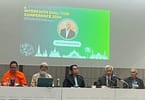VIENTIANE – Human capital development, identifying top tourism products, and marketing and promotion resonated as key areas on which Lao tourism needs to focus in preparing for the ASEAN Economic Community’s (AEC) launch, according to participants at the 16th Lanith Symposium, “Five Months and Counting,” held on Friday, July 31, 2015, at Lao Airlines head office at Wattay International Airport.
Lao Ministry of Information, Culture, and Tourism (MoICT) Vice Minister Chaleune Warinthrasak opened the event, stating, “To compete in the AEC, we need to aim for quality tourists by increasing marketing and promotion and our efforts in human capital development (HCD). The government and private sector will also continue to engage in product development.”
These endeavours are in line with the ASEAN Tourism Strategic Plan (ATSP) 2011-2015 and the early stages of the ATSP 2016-2025, keynote speaker ASEAN Secretariat representative Eddy Kresmedi told the 70-plus participants at the Luxembourg Development Cooperation-backed event.
“It is imperative that the private sector be closely involved in selecting and developing tourism products, as well as in identifying three-country regional packages for promotion on aseantourism.travel,” Mr Kresmedi said.
He stated the current ATSP places priority on natural, cultural, and heritage sites as well as community-based tourism (CBT) and river cruise tourism, which has good potential in Laos.
However, he pointed to challenges such as the current need for multiple visas, which hinders intra-regional tourism, and issues regarding seamless cross-border road vehicle traffic.
Mr Kresmedi emphasised that HCD remains high on the list for the early years of ATSP 2016-2025, and the ASEAN Mutual Recognition Agreement (MRA) currently covers standards for traditional tourism and hospitality employees.
He said MRAs benefit the industry as they guarantee conformity to ASEAN standards, recognize staffs’ skills, and improve the overall quality of regional human resources. Staff, who register in the MRA system and receive MRA certification, may be eligible to work in other ASEAN countries, depending on quotas.
Mr Kresmedi pointed to Lanith’s Passport for Success skills training program and the two-year Lanith Diploma as models for achieving MRA certification, while also clearly presenting a pathway to career advancement, a point many speakers and participants feel hinders the industry in recruiting staff.
According to Exo Travel Managing Director Duangmala Phommavong, “Secondary school students do not see a career path in tourism and hospitality, and there is no marketing for these careers in their schools.” She added that most young graduates want to be “the big boss”, and perceive the service industry as a low-status career.
Asian Development Bank Senior Portfolio Management Specialist and the symposium’s panel moderator Steven Schipani suggested an internal marketing campaign via various media channels would help create awareness among Lao people in the industry’s various career paths.
JOBS 108 Managing Director and symposium panellist Keovisouk Dalasane agreed, stating “They need to know there are career paths, and institutes like Lanith can take them there.” He added the industry must devise a way to ensure employers and employees know about MRAs and the need to increase their level of service standards to reach ASEAN benchmarks.
MoICT Division of Tourism Development Director and co-keynote speaker Somxay Sipaseuth acknowledged that Laos lacks skilled labour, and HCD is among the government’s “priority actions,” as are tourism product development and marketing.
Mr Sipaseuth noted Laos’ product development supports ATSP 2016-2025, which adds MRA criteria for six new areas: homestays, clean tourist cities, green hotels, public toilets, community-based tourism, and spas.
“Natural tourism sites are Laos’ top priority, but we are also heavily focussing on cultural and heritage products led by three UNESCO World Heritage sites, CBT homestays and handicrafts, and river tours.” He added that 10 villages are being assessed to see if they meet ASEAN standards.
Mr Sipaseuth noted public-private partnership (PPP) opportunities in product development, such as the joint project between the Ministry of Education and Sports, Lao World Real Estate Company, and Champassak Grand Hotel to build the Vientiane Grand Hotel, which will be operated by Lanith.
He added that improving existing products and the selection of a “Clean City”, which is being supported by the 16th Lanith Symposium sponsor, German Development Cooperation (GIZ), will require close cooperation with the private sector. He said challenges include competition among quality products and attracting investment.
Mr Sipaseuth emphasised that to increase tourism expenditures, Laos needs to implement ASEAN standards, create a platform to facilitate PPPs and tap into the private sector’s experience and knowledge, increase promotional activities, and add value to nature-based products.
Lao Association of Travel Agents representative and symposium panellist Saysamone Srithirath added that Lao tourism needs to clearly identify its best products, as many are unattractive to visitors. “There is a lack of marketing research and promotion,” she said. “We need to know what tourists want, and promote what we have to fill their needs.”
TripAdvisor ASEAN Markets Manager and symposium panellist Matthew Zatto commented that tourists are increasingly looking for new experiences, and studies show, “Most are influenced by cultural interactions.”
Mr Zatto added that in the near future, tourists from ASEAN countries will spend more. “Travel is still growing here, whereas more experienced Western travellers are willing to spend more on tourism. Once ASEAN tourists are experienced, like Singapore travellers, their expenditures will grow.
WHAT TO TAKE AWAY FROM THIS ARTICLE:
- VIENTIANE – Human capital development, identifying top tourism products, and marketing and promotion resonated as key areas on which Lao tourism needs to focus in preparing for the ASEAN Economic Community's (AEC) launch, according to participants at the 16th Lanith Symposium, “Five Months and Counting,” held on Friday, July 31, 2015, at Lao Airlines head office at Wattay International Airport.
- Mr Kresmedi pointed to Lanith's Passport for Success skills training program and the two-year Lanith Diploma as models for achieving MRA certification, while also clearly presenting a pathway to career advancement, a point many speakers and participants feel hinders the industry in recruiting staff.
- Lao Ministry of Information, Culture, and Tourism (MoICT) Vice Minister Chaleune Warinthrasak opened the event, stating, “To compete in the AEC, we need to aim for quality tourists by increasing marketing and promotion and our efforts in human capital development (HCD).





















